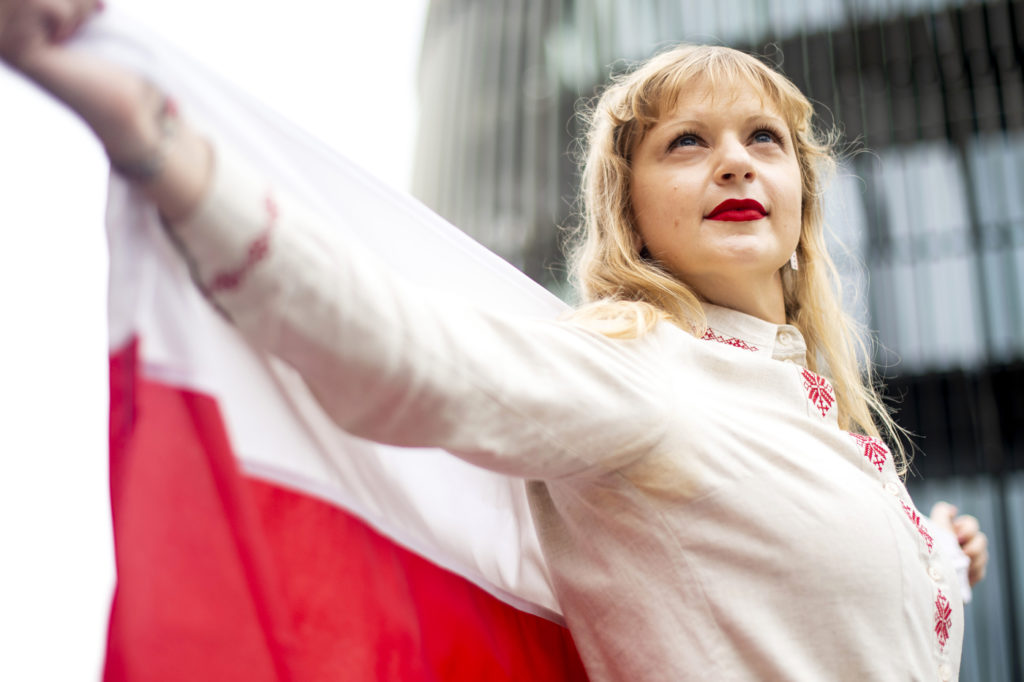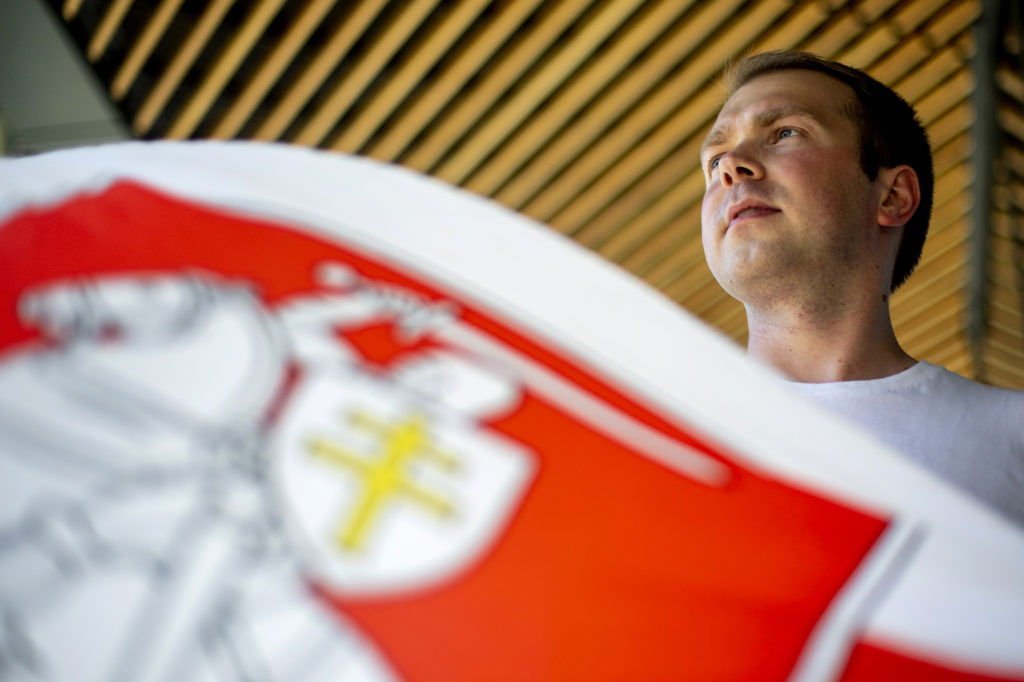This article previously appeared on News@Northeastern. It was written by Khalida Sarwari.
Engulfed in weeks of protests demanding an end to President Alexander Lukashenko's rule, Belarus is rewriting its story through the force of its young people, says Julia Ivy, an associate professor of international business and strategy at Northeastern. And as it does, the former Soviet republic is setting an example for the rest of the world, the United States included.
Demonstrations of historic proportions erupted across the country in August leading up to and following the disputed victory of Lukashenko in the 2020 presidential election. Independent observers have criticized it for not being free and fair.

Ivy, a Belarusian native who has studied entrepreneurial behavior in a low-trust versus high-trust environment, says the uprising of hundreds of thousands of people is the result of a nation that has had enough of Lukashenko's 26-year authoritarian rule. While there have been attempts of opposition in previous similarly contested elections, this time the Belarusians are putting their differences aside, Ivy says, to unite in their quest for freedom and democracy. They are fighting back with smiles, songs, white ribbons—a symbol of Belarus' opposition movement— as well as the white and red flag independent Belarus adopted in 1991 after the fall of the Soviet Union, and flowers.
“Belarus was a ‘low-trust environment' for all these 26 years,” Ivy says. “Each person shared frustration with Lukashenko only within a small circle of trust. They were scared to share their views beyond this small circle and just kept doing their jobs and raising families without much hope for change. Only in 2020, they realized that the majority of people in Belarus actually share their beliefs, so these small circles of trust joined thousands of others.”
Ivy defines a low-trust environment as one in which the radius of trust is typically small. In a low-trust society, she says, people tend to trust and support only those they know personally.
“This is the us-versus-them, where the number of ‘us' is small as each member must be known personally and verified as the ‘right' person based on shared beliefs,” she explains. “Everybody else is ‘them.'”
Conversely, in a high-trust environment, the radius of trust is large, and it includes strangers. In high-trust societies, citizens tend to trust and support each other, Ivy says—even if they don't know each other—because they share similar beliefs and values.
Ivy says that when she initially began her research in this field in 2004, she conducted a case study in which she compared Belarus, deemed as a low-trust society at the time, to a small town in Alaska, where the community supported each other. But since then, she says that declining trust in the government and in other institutions has divided the U.S.
“Unfortunately in the U.S. right now we are losing this feeling of one, which is what will make America great again,” she says. “As much as Belarus can learn from America about entrepreneurship and democracy, America should learn from Belarus the beauty of being together, to be the nation of one, of a high-trust environment.”
Albeit peaceful, the anti-government demonstrations in Belarus have been met with violent suppression by the authorities, says Ivy. There are documented cases of torture and inhumane treatment of detainees, including sexual abuse and rape.
Young people, who have filled the streets in droves, also have been targeted by police and by assailants, Ivy says. Videos shared on social media showed student protesters in Minsk being struck by officers, and dragged away and thrown into vans.

Larissa Doroshenko, a postdoctoral teaching associate in the College of Arts, Media and Design who studies how social media plays a role in political campaigns, sustains protests, and promotes disinformation campaigns, is examining how Telegram, an encrypted social media application, has fueled an unprecedented grassroots movement in the country. Demonstrations in previous years were comparatively smaller, she says, and organized primarily by political groups.
“I don't think this dissatisfaction was as widespread and even though people were using social media to spread this information, to self-organize, it just didn't pick up from the grassroots as much,” says Doroshenko, who is also a member of the Communication Media and Marginalization Lab at the Network Science Institute at Northeastern. “It was mostly a group of activists and people who are politically involved and are very pro-Democratic, but it wasn't picked up widely by the majority of the society.”
Doroshenko credits Telegram for the success of this latest round of demonstrations, which she says appear to be led by ordinary Belarusians who disagree with the regime. With more than two million subscribers, the platform's biggest channel, NEXTA, helps citizens share information and videos, organize meetings, and coordinate protests. Because independently verified exit polls are prohibited in Belarus, she says the app has also been used by the grassroots initiative Honest People as an alternative method of counting votes. The channels can be publicly viewed.
“I think by itself social media is not a magic tool that can make people want democracy, but it's a useful tool to self-organize and sustain this protest,” Doroshenko says. “Activists create Telegram chats for their local communities across the country, showing to themselves and others that they are becoming a united majority, which shares common views and values.”
The researcher will be looking at NEXTA and other Telegram channels to understand their network structure, their number of subscribers, and how the platform has driven change in the country since the protests began six weeks ago.

Alexey Petrusevich, who is studying computer science at Northeastern and serving a co-op this fall at an e-commerce company in Boston, has been closely following the unrest in his native country.
As a student, he's been unnerved to see the way police have responded to his peers—even on Knowledge Day, which falls on September 1 and marks the beginning of the school year in Belarus.
“It's very sad to see that when people should be celebrating their advancement in academia, instead you see police in full riot gear beating them up and taking them to prisons and jails, and giving them fines for doing absolutely nothing [wrong],” Petrusevich says.
He says he has never been prouder of his compatriots. Owners of small businesses often bring water, food, and coffee to protesters. Individuals and groups are collecting funds for workers who are on strike in state-controlled factories and for people who were injured and tortured during the demonstrations.
“I'm really glad to see this is happening,” says Petrusevich. “It's a rebirth of a nation. I think for Belarus it is truly a historical moment and I'm so glad that I can observe it and see it with my own eyes.”
After the collapse of the Soviet Union, Belarus gained its independence in 1991 and briefly supported democracy and a free market economy. But, Ivy says, the transition was “chaotic and painful,” one marked by crime and corruption.
Then in 1994, on the pretense of eradicating the problems that plagued his country, Lukashenko, the former director of a Soviet collective farm, won his first election. It was the only election that was credibly deemed free and fair by international monitors.
Since then, he has gradually wiped away democratic institutions, arrested or forced into exile opponents, and suppressed political protests. Lukashenko has moved Belarus back in the direction of a quasi-Soviet state, says Ivy. He likens himself to a father figure and says he's the only one who can save or protect the country, she says.
“It's like a cult,” she says. “People say, ‘No thank you,' but everybody who says ‘No thank you' goes to prison.”
During Lukashenko's 26-year reign, anytime his regime caught wind of an uprising, it acted swiftly to suppress dissidents, says Ivy. And trapped in a state of helplessness, the people, scarred by the devastation of the second world war and still reeling from the Chernobyl disaster (which received about 60 percent of the contamination that fell on the former Soviet Union following the event), remained mostly subservient.
Read more at News@Northeastern.
